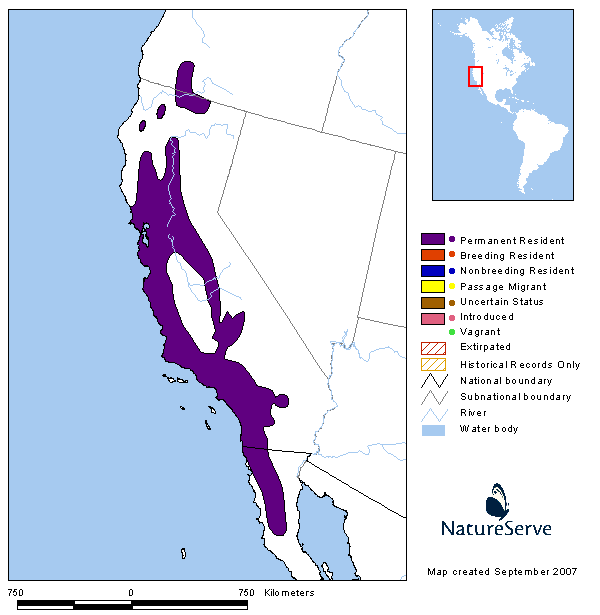Sure it is a Plain Titmouse, or at least it used to be. The Plain Titmouse (Parus inornatus) was split and reclassified in 1997 as sibling species, the Oak Titmouse (Baeolophus inornatus) and the Juniper Titmouse (Baeolophus ridgwayi).
The Oak Titmouse, pictured above (click on photos for full sized images), would be a California endemic if not for its spill over into Southern Oregon and Baja California. Range map courtesy of Nature Serve.
They are a non-migratory, cavity nesting species that mate for life and at least two pair have been nesting on my property every year since I’ve lived here!
I have three bluebird trails that I monitor every year and the Oak Titmouse is always the first species taking up residence on two of those trails. They may be small at only 5 3/4 inches but they are not timid and they don’t seem to take any guff from other birds, even much larger more aggressive species.
When I checked my nest boxes, just a few days ago, I was pretty sure that it was nearing time for these nestlings to fledge. I had never been able to catch this event on film so I took my camera and camcorder to the nest site and waited.
This first video was filmed late Saturday, only a few hours before sunset. In it you will see the adults bringing small offerings to the nest box entrance, then backing away.
Normally the parents dive into the nest box with a beak full of food and shortly afterward exit with a fecal sac to discard. This behavior of showing up at the entrance and backing off, calling the nestlings from a nearby branch, convinced me that they were trying to coax them from the nest.
After being unsuccessful at luring the youngsters out, the adults went back to feeding them. But the nestlings did come to the cavity entrance and peek out.
httpv://youtu.be/LK7p0WYN2u0
I was pretty sure that Sunday morning would be the best time to witness the Oak Titmouse nestlings fledge, so I headed back to the nest site at sunrise. I grabbed a shot of one of the parents with a worm while they were still feeding the chicks.
This behavior of teasing the nestlings with food and retreating to a nearby branch and calling them seems to be a common practice for many cavity nesting species.
At the beginning of this video, you will hear the adults giving their typical snibit, snibit, snibit call as the chicks come to the entrance and answer back.
At the 1:40 mark, a pair of White-breasted Nuthatches, which are just beginning to build a nest a hundred yards away, visit the nest box and one of them actually peers into the box!
At the 3:15 mark, both adults are at the nest at the same time. They had been going in and out of the nest in rapid succession, a behavior I had not witnessed but I imagine they could be enticing the youngsters to fly out and demonstrating their technique.
At the 5:25 mark, the first nestling takes to the air. The other four followed within 30 minutes of this bravest sibling.
httpv://youtu.be/ZT1ZUiY_pXU

















Thank you Larry!!! My partner and I watched every second of these videos with rapt attention. The oak titmouse is our “spark bird” and we have a pair nesting in our backyard right now — we think the babies will fledge any day so this was not only entertaining, it was very informative. We love all birds but especially these little raspy charmers.
Thanks for these wonderful videos!! I was trying to figure out if I have the Juniper or the Oak titmouse here in Eagle Point Oregon. I have a tone of these little guys. I really love them. I don’t find them drab. I really find their silvery gray feathers with the little tuft and their bold investigations around the area enchanting. They are one of my favorites here.
Do the osk tit mice return to their nesting box after the young ones fledge?